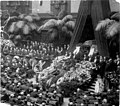German Democratic Party
This article may be expanded with text translated from the corresponding article in German. (December 2017) Click [show] for important translation instructions.
|
German Democratic Party Deutsche Demokratische Partei | |
|---|---|
 | |
| Founded | 1918 (1918) |
| Dissolved | 1930 (1930) |
| Preceded by | Progressive People's Party |
| Succeeded by | German State Party |
| Newspaper | Supported by Vossische Zeitung and Frankfurter Zeitung |
| Youth wing | Jungdemokraten |
| Ideology | Classical liberalism[1] Social liberalism[2][3] Republicanism[4][5] Economic liberalism[4] |
| Political position | Centre[6] |
| Colors | Black Red Gold (republican colors)[7] |
| |
The German Democratic Party (German: Deutsche Demokratische Partei, DDP) was founded in November 1918[8] by leaders of the former Progressive People's Party (German: Fortschrittliche Volkspartei), left-wing members of the National Liberal Party (German: Nationalliberale Partei) and a new group calling themselves the Democrats (German: Demokraten).
In 1930, the party changed to the German State Party (German: Deutsche Staatspartei).
Contents
1 Politics
2 People and governments
3 Election results
4 After 1945
5 Pictures
6 See also
7 References
8 Further reading
Politics
The Democrats were a more left-wing or social liberal party whereas the German People's Party was right-wing liberal. Many of the leading figures in the party had been supporters of Imperial Germany's aim of Weltpolitik[9] and Mitteleuropa.[citation needed]
Along with the Social Democrats and the Centre Party, the Democratic Party was most committed to maintaining a democratic, republican form of government. Its social bases were middle-class entrepreneurs, civil servants, teachers, scientists and craftsmen. It considered itself also a devotedly national party and opposed the Treaty of Versailles, but it emphasized on the other hand the need for international collaboration and the protection of ethnic minorities. The party was the one voted for by most Jews.[10] The party was attacked by some for being a party of Jews and professors.[11]
People and governments
The party's first leader was Protestant parish priest Friedrich Naumann, who was popular and influential, but he failed with his Nationalsozialer Verein ten years earlier to link progressive intellectuals with the working class. He died early in 1919. Other well-known politicians of the DDP were Hugo Preuß, the main author of the Weimar Constitution; and the eminent sociologist Max Weber. Hjalmar Schacht, president of the Reichsbank and one of the founders of the party, left the party in 1926 and became a supporter of Adolf Hitler.
Nearly all German governments from 1918 to 1931 included ministers from the DDP, such as Walther Rathenau, Eugen Schiffer, Hugo Preuß, Kurt Riezler, Otto Gessler, Max Weber and Erich Koch-Weser. From their 18% share of the first German federal elections under proportional representation in 1919, they dropped, for example, to 4.9% in the 1928 German federal election and to 1.0% in the November 1932 German federal election.
The party merged with the more right-leaning Young German Order to form the German State Party in 1930. With Ludwig Quidde (Nobel Peace Prize winner of 1927) and others, the party had a pacifist wing which left the party in 1930 and founded the Radical Democratic Party, which represented radical democratic and more left-wing policies.
Other prominent figures associated with the party include the philosophers Ernst Cassirer[12] and Ernst Troeltsch, and the pacifist Hellmut von Gerlach.
Election results
| Election year | Votes | % | Seats | +/– |
|---|---|---|---|---|
1919 | 5,641,825 | 18.6 (3rd) | 75 / 423 | New Party |
1920 | 2,333,741 | 8.3 (6th) | 39 / 459 | |
May 1924 | 1,655,129 | 5.7 (7th) | 28 / 472 | |
December 1924 | 1,919,829 | 6.3 (6th) | 32 / 493 | |
1928 | 1,479,374 | 4.8 (6th) | 25 / 491 |
After 1945
After 1945, former politicians of the DDP joined mainly the new Free Democratic Party (1945/1948) as did the liberals from the German People's Party. First Federal President Theodor Heuss, a journalist and professor of history, had been a German State Party deputy in 1933. In the Soviet occupation zone, the liberal leader was former DDP minister Wilhelm Külz.
Other DDP members went to the Christian Democrats, such as Ernst Lemmer, the former leader of the Young Democrats and Federal Minister in 1956–1965.
Pictures

Feminist and DDP co-founder Helene Lange

Funeral celebration for Walther Rathenau, the murdered DDP minister of foreign affairs, 1922

Psychologist Willy Hellpach, DDP candidate for Reich Presidency in 1925

DDP ministers Wilhelm Külz (left, interior) and Otto Gessler (army), 1926

One of the political leaders of the party, Hermann Dietrich, 1926

Ludwig Quidde, winner of the Nobel Peace Prize of 1927

DDP flag 1929

Former DDP minister Bernhard Dernburg in 1931

Allied prisoner Hjalmar Schacht in 1945

Federal President Theodor Heuss in 1953
See also
- Democratic Party of Germany
- Liberalism
- List of liberal parties
- Liberalism in Germany
- Weimar Republic
References
^ Mommsen, Hans (1996). The Rise and Fall of Weimar Democracy. University of North Carolina Press. p. 58. ISBN 0-8078-2249-3..mw-parser-output cite.citation{font-style:inherit}.mw-parser-output .citation q{quotes:"""""""'""'"}.mw-parser-output .citation .cs1-lock-free a{background:url("//upload.wikimedia.org/wikipedia/commons/thumb/6/65/Lock-green.svg/9px-Lock-green.svg.png")no-repeat;background-position:right .1em center}.mw-parser-output .citation .cs1-lock-limited a,.mw-parser-output .citation .cs1-lock-registration a{background:url("//upload.wikimedia.org/wikipedia/commons/thumb/d/d6/Lock-gray-alt-2.svg/9px-Lock-gray-alt-2.svg.png")no-repeat;background-position:right .1em center}.mw-parser-output .citation .cs1-lock-subscription a{background:url("//upload.wikimedia.org/wikipedia/commons/thumb/a/aa/Lock-red-alt-2.svg/9px-Lock-red-alt-2.svg.png")no-repeat;background-position:right .1em center}.mw-parser-output .cs1-subscription,.mw-parser-output .cs1-registration{color:#555}.mw-parser-output .cs1-subscription span,.mw-parser-output .cs1-registration span{border-bottom:1px dotted;cursor:help}.mw-parser-output .cs1-ws-icon a{background:url("//upload.wikimedia.org/wikipedia/commons/thumb/4/4c/Wikisource-logo.svg/12px-Wikisource-logo.svg.png")no-repeat;background-position:right .1em center}.mw-parser-output code.cs1-code{color:inherit;background:inherit;border:inherit;padding:inherit}.mw-parser-output .cs1-hidden-error{display:none;font-size:100%}.mw-parser-output .cs1-visible-error{font-size:100%}.mw-parser-output .cs1-maint{display:none;color:#33aa33;margin-left:0.3em}.mw-parser-output .cs1-subscription,.mw-parser-output .cs1-registration,.mw-parser-output .cs1-format{font-size:95%}.mw-parser-output .cs1-kern-left,.mw-parser-output .cs1-kern-wl-left{padding-left:0.2em}.mw-parser-output .cs1-kern-right,.mw-parser-output .cs1-kern-wl-right{padding-right:0.2em}
^ Van De Grift, Liesbeth (2012). Securing the Communist State: The Reconstruction of Coercive Institutions in the Soviet Zone of Germany and Romania, 1944-48. Lexington Books. p. 41. ISBN 978-0-7391-7178-3.
^ Lash, Scott; Urry, John (1987). The End of Organized Capitalism. University of Wisconsin Press. p. 27. ISBN 0-7456-0068-9.
^ ab Kurlander, Eric (2006). The Price of Exclusion: Ethnicity, National Identity, and the Decline of German Liberalism, 1898–1933. Berghahn Books. p. 197. ISBN 1-8454-5069-8.
^ Maier, Charles S. (1975). Recasting Bourgeois Europe: Stabilization in France, Germany and Italy in the Decade after World War I. Princeton University Press. p. 56. ISBN 0-691-05220-4.
^ Lee, Stephen J. (1998). The Weimar Republic. Routledge. p. 23. ISBN 0-415-17178-4.
^ Hugo Preuss (2008). Schwarz-Rot-Gold: Zum Nürnberger Parteitag (1920). Gesammelte Schriften – Vierter Band: Politik und Verfassung in der Weimarer Republik. Mohr Siebeck. p. 155.
^ "German Democratic Party (DDP) Election Poster (1924)".
^ Smith, Woodruff D. (1989) The Ideological Origins of Nazi Imperialism Oxford University Press p196-7
^ Niewyk, Donald L. (1980) The Jews in Weimar Germany Louisiana State University Press p31
^ Baumgarten, Albert I. (17 March 2010). Elias Bickerman as a historian of the Jews : a twentieth-century tale. Tübingen: Mohr Siebeck. p. 73. ISBN 9783161501715.
^ Jones, Larry Eugene (2001). Crossing Boundaries: The Exclusion and Inclusion of Minorities in Germany and the United States. Berghahn Books. p. 125.
Further reading
Frye, Bruce B. (1963). "The German Democratic Party 1918–1930". Political Research Quarterly. 16 (1): 167–179. doi:10.1177/106591296301600112.









